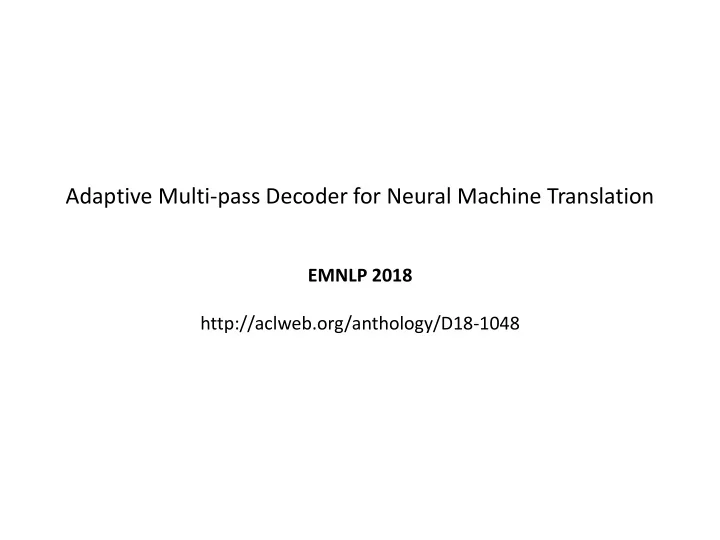

Adaptive Multi-pass Decoder for Neural Machine Translation EMNLP 2018 http://aclweb.org/anthology/D18-1048
Neural Machine Translation(NMT) The encoder-decoder are widely used in neural machine translation • the encoder transforms the source sentence into continuous vectors – the decoder generates the target sentence according to the vectors – the alternatives of the encoder/decoder can be RNN/CNN/SAN –
Motivation Traditional attention-based NMT adopts one-pass decoding to generate • the target sentence Recently, the polishing mechanism-based approaches demonstrate their • effectiveness these approaches first create a complete draft using the conventional models – and then polish this draft based on the global understanding of the whole draft – Divided into two categories • – post-editing - > a source sentence e is first translated to f , and then f is refined by another model – with respect to post-editing, the generating and refining are two separate processes – end-to-end approaches -> most relevant to our work
Related Work Deliberation Networks (Xia et al. NIPS 2017) • consist of two decoders: a first-pass decoder generates a draft, which is taken as input of – second-pass decoder to obtain a better translation The second-pass decoder has the potential to generate a better sequence by looking – into future words in the raw sentence ABDNMT (Zhang et al. AAAI 2018) • adopt a backward decoder to capture the right-to-left target-side contexts – assist the second-pass forward decoder to obtain a better translation – the idea of multi-pass decoding is not well explored •
Adaptive Multi-pass Decoder Consist of three components -> encoder, multi-pass decoder and policy • network multi-pass decoder -> polish the generated translation with decoding over and over – policy network -> choose the appropriate decoding depth (the number of decoding – passes)
Multi-pass Decoder Similar to the conventional decoder, the multi-pass decoder leverages a • attention model to capture the source context from the source sentence Towards considering the context information from generated translation, • another attention model is utilized to achieve this target The attended hidden states are derived from the inference using the • previous decoder
Policy Network The policy network determines to continue decoding or halt -> two actions • The hidden states of policy network are computed with RNN to model the • difference between the consecutive decoding We use attention model to capture useful information and take the output • as input of RNN We use REINFORCE algorithm to train the policy network, and take BLEU • as the reward
Experiments Chinese-English translation task • 1.25M sentence pairs from LDC corpora – use NIST02 as development dataset and NIST03, NIST04,NIST05,NIST06 and NIST08 as – testing datasets take BLEU as evaluation metric – The average decoding depth is 2.12 •
Case Study
Conclusion We first explore to generate the translation with fixed decoding depth • Further we leverage policy network to determines continuing decoding or • halt and train this network using reinforcement learning We demonstrate its effectiveness on Chinese-English translation task •
Thanks & QA
Recommend
More recommend